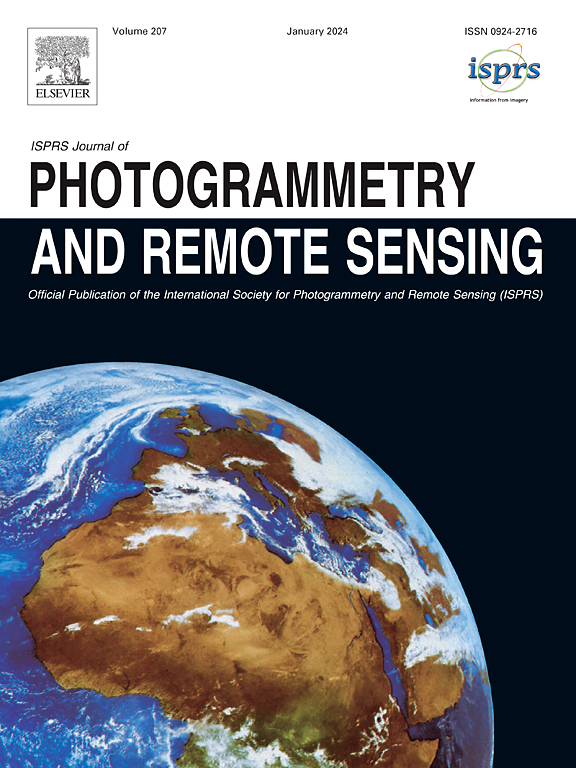Robust cutting plane pure integer programming phase unwrapping algorithm considering fringe frequency for dual-baseline InSAR
IF 10.6
1区 地球科学
Q1 GEOGRAPHY, PHYSICAL
ISPRS Journal of Photogrammetry and Remote Sensing
Pub Date : 2025-05-26
DOI:10.1016/j.isprsjprs.2025.05.017
引用次数: 0
Abstract
Multi-baseline (MB) phase unwrapping (PU) represents the core processing step of MB InSAR, which overcomes discontinuous terrain height estimation. However, MBPU faces the challenge of low noise robustness. A new robust cutting plane–pure integer programming (CP-PIP) PU algorithm that considers the fringe frequency for dual-baseline InSAR is proposed to address this problem. First, we establish a closed-region PIP model with one objective function and two constraints using prior information about the fringe frequency and the relationship between the interferometric phase difference and the same relative elevation. Then, after determining secant equations, we begin bidirectional traversal with the integer solution of one ambiguity number variable to verify whether another ambiguity number variable satisfies the integer condition using the CP-PIP method. Finally, two-neighborhood phase gradients in both the azimuth and range directions are introduced to extract abrupt topographic change points, and the ambiguity number of the mis-unwrapping point at the center of the window function is replaced by that with the highest frequency to complete the PU. Comprehensive comparisons using both simulated data and real data confirm the effectiveness, universality, and reliability of our approach. Compared with the most effective minimum-cost flow (MCF) algorithm in single-baseline (SB) PU and the two-stage programming approach (TSPA) in MBPU, the proposed algorithm not only achieves better and more stable unwrapping in the region of abrupt phase change and dense interferometric fringes but also improves the unwrapping accuracy. The root mean square error of the proposed algorithm is less than those of MCF and TSPA algorithms by more than 60% and 10%, respectively. The full implementation of CP-PIP is publicly available https://github.com/Shiji-Yang/MBPU.git.
考虑条纹频率的双基线InSAR鲁棒切割平面纯整数规划相位展开算法
多基线相位解包裹(Multi-baseline phase unwrap, PU)是多基线InSAR的核心处理步骤,克服了地形高度估计不连续的问题。然而,MBPU面临着低噪声鲁棒性的挑战。针对这一问题,提出了一种考虑条纹频率的鲁棒切割平面纯整数规划(CP-PIP)算法。首先,利用条纹频率的先验信息和干涉相位差与相同相对高程的关系,建立了具有一个目标函数和两个约束条件的封闭区域PIP模型;然后,在确定割线方程后,我们开始用一个模糊数变量的整数解进行双向遍历,使用CP-PIP方法验证另一个模糊数变量是否满足整数条件。最后,引入方位角方向和距离方向上的两邻域相位梯度提取地形突变点,并将窗函数中心未解包裹点的模糊数替换为频率最高的模糊数,完成PU。模拟数据和实际数据的综合比较证实了该方法的有效性、通用性和可靠性。与单基线(SB) PU中最有效的最小代价流(MCF)算法和MBPU中最有效的两阶段规划方法(TSPA)相比,该算法不仅在突变相位和密集干涉条纹区域实现了更好、更稳定的解包裹,而且提高了解包裹精度。该算法的均方根误差比MCF和TSPA算法分别小60%和10%以上。CP-PIP的完整实现是公开的https://github.com/Shiji-Yang/MBPU.git。
本文章由计算机程序翻译,如有差异,请以英文原文为准。
求助全文
约1分钟内获得全文
求助全文
来源期刊

ISPRS Journal of Photogrammetry and Remote Sensing
工程技术-成像科学与照相技术
CiteScore
21.00
自引率
6.30%
发文量
273
审稿时长
40 days
期刊介绍:
The ISPRS Journal of Photogrammetry and Remote Sensing (P&RS) serves as the official journal of the International Society for Photogrammetry and Remote Sensing (ISPRS). It acts as a platform for scientists and professionals worldwide who are involved in various disciplines that utilize photogrammetry, remote sensing, spatial information systems, computer vision, and related fields. The journal aims to facilitate communication and dissemination of advancements in these disciplines, while also acting as a comprehensive source of reference and archive.
P&RS endeavors to publish high-quality, peer-reviewed research papers that are preferably original and have not been published before. These papers can cover scientific/research, technological development, or application/practical aspects. Additionally, the journal welcomes papers that are based on presentations from ISPRS meetings, as long as they are considered significant contributions to the aforementioned fields.
In particular, P&RS encourages the submission of papers that are of broad scientific interest, showcase innovative applications (especially in emerging fields), have an interdisciplinary focus, discuss topics that have received limited attention in P&RS or related journals, or explore new directions in scientific or professional realms. It is preferred that theoretical papers include practical applications, while papers focusing on systems and applications should include a theoretical background.
 求助内容:
求助内容: 应助结果提醒方式:
应助结果提醒方式:


